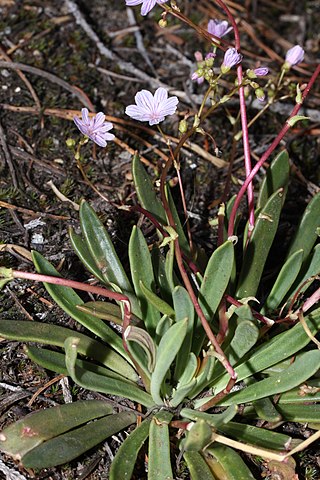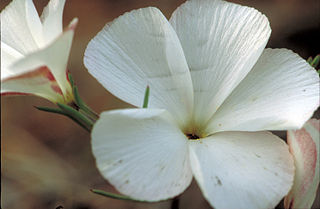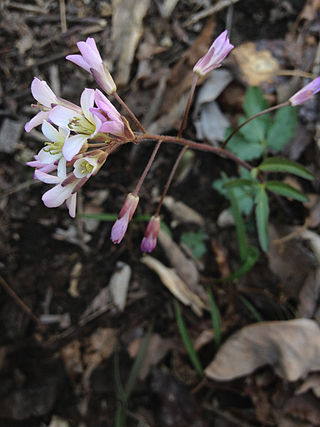
Cardamine is a large genus of flowering plants in the mustard family, Brassicaceae, known as bittercresses and toothworts. It contains more than 200 species of annuals and perennials. Species in this genus can be found in diverse habitats worldwide, except the Antarctic. The name Cardamine is derived from the Greek kardaminē, water cress, from kardamon, pepper grass.

Horkelia daucifolia is a species of flowering plant in the rose family known by the common name carrotleaf horkelia. It is native to the Klamath Mountains and surrounding ranges in northern California and southern Oregon. It grows on mountain slopes and fields, often on serpentine soils. It is a perennial herb that produces a rosette of leaves, each five to 15 centimeters long. Each leaf is made up of lobed, hairy leaflets that are one or two centimeters long. The plant produces erect stems up to 30 centimeters tall and bright red or greenish in color. The inflorescence holds several flowers, each with narrow, pointed bractlets and wider, reflexed green or pinkish sepals. The five narrow petals are white, yellow, or pink.

Allium tuolumnense is a rare species of wild onion, known by the common name Rawhide Hill onion.

Claytonia exigua is a species of wildflower known by the common names serpentine springbeauty and pale claytonia, in the family Montiaceae.
Antennaria suffrutescens is a species of flowering plant in the family Asteraceae known by the common names evergreen pussytoes and evergreen everlasting. It is native to southwestern Oregon and far northeastern California. It grows in coniferous forests in the mountains, sometimes on serpentine soils.
Arnica spathulata is a rare North American species of flowering plant in the family Asteraceae, known by the common name Klamath arnica. It is native to the Klamath Mountains of northwestern California and southwestern Oregon. It grows in woodland habitat, almost exclusively on serpentine soils.

Cardamine nuttallii is a species of cardamine known by the common name Nuttall's toothwort. It is native to western North America from British Columbia to California, where it grows in moist mountain habitats.
Cardamine occidentalis is a species of Cardamine known by the common name big western bittercress. It is native to western North America from Alaska to northwestern California, where it grows in moist mountain habitats.

Cardamine oligosperma is a species of Cardamine known by the common name little western bittercress. It is native to western North America from Alaska to California to Colorado, where it grows in moist mountain habitats.

Lewisia columbiana, the Columbian lewisia, is a species of flowering plant in the family Montiaceae. It is native to the western United States and British Columbia, where it grows in rocky mountain habitats.

Lewisia oppositifolia is a rare species of flowering plant in the family Montiaceae known by the common name opposite-leaf lewisia. It is native to the Klamath Mountains of Josephine County, Oregon, and Del Norte County, California, where it is a local serpentine endemic generally found in moist areas. This is a perennial herb growing from a small taproot and caudex unit. It produces a basal rosette of several lance-shaped, blunt-tipped fleshy leaves up to 11 centimeters long. There are sometimes smaller leaves located on the lower stem. The inflorescence is made up of one or more erect stems up to about 20 centimeters long, each bearing 1 to 6 flowers. The flower has 8 to 11 white to pale pink petals with blunt or jagged tips, each between 1 and 2 centimeters long. At the center are several stamens with pale anthers. This plant has a limited distribution and it is threatened by human activity in the area, such as logging.

Linanthus dichotomus is a species of flowering plant in the phlox family known by the common name eveningsnow. It is native to western North America, including most of the southwestern United States, where it is a common member of the flora in a number of habitat types. It is often found on the serpentine soils of California. This is an annual herb producing several thin, waxy, erect stems up to 20 centimeters tall. The leaves are divided into linear lobes 1 or 2 centimeters long. The inflorescence produces a cyme of vespertine flowers which unroll into funnel-shaped corollas. The white lobes are just over a centimeter long and have purple shading on the undersides.

Monardella purpurea is a species of flowering plant in the mint family known by the common names Siskiyou monardella and serpentine monardella.
Packera macounii is a species of flowering plant in the aster family known by the common name Siskiyou Mountains ragwort. It is native to the west coast of North America from British Columbia to far northern California, where it grows in chaparral and mountain forests, often on serpentine soils.
Streptanthus barbiger is a species of flowering plant in the mustard family known by the common name bearded jewelflower. It is endemic to California, where it is limited to the North Coast Ranges. It grows in woodlands and chaparral habitat, often on serpentine soils. It is an annual herb producing a branching stem up to about 80 centimeters in maximum height. Leaves near the base of the stem are lance-shaped to oval and pointed, usually with toothed edges, the blades measuring up to 7 centimeters long. Leaves higher on the stem may be longer but are narrower and have smooth edges. Flowers occur at intervals along the upper stem. Each has a spherical to urn-shaped calyx of greenish yellow or purple sepals under a centimeter long. Whitish or purple-tinged petals up to a centimeter long emerge from the tip. The fruit is a long, flat, curving silique which may be 7 centimeters in length.
Streptanthus drepanoides is an uncommon species of flowering plant in the mustard family known by the common name sicklefruit jewelflower. It is endemic to California, where it is known from a scattered distribution throughout several mountain ranges in the northern part of the state, including the Klamath Mountains. It is a resident of chaparral and woodlands, generally on serpentine soils. It is an annual herb producing a mostly hairless, waxy stem up to 40 or 45 centimeters tall. The ephemeral basal leaves have round or oval blades, sometimes edged with teeth. Leaves higher on the stem have fleshy oval blades that clasp the stem, the lower ones each measuring up to 9 centimeters long by 7.5 wide. Flowers occur at intervals along the upper stem. Each has an urn-shaped calyx of greenish or yellowish sepals under a centimeter long with whitish or purplish, purple-veined petals emerging from the tip. The fruit is a straight or sickle-shaped curving silique up to 9 centimeters long.
Streptanthus morrisonii is an uncommon species of flowering plant in the mustard family known by the common name Morrison's jewelflower. It is endemic to California, where it is known from the North and Central Coast Ranges. It is limited to serpentine soils in chaparral and forest habitat. It is considered a species complex which includes Streptanthus brachiatus. S. morrisonii is divided into four subspecies and is variable. In general, it is a biennial herb producing a hairless, waxy stem up to 1.2 to 1.5 meters in maximum height, often branching at the tip. The basal leaves have fleshy, lance-shaped blades 3 to 5 centimeters long borne on petioles. The blades are gray-green on the upper surface and purple or purple-mottled underneath. Leaves higher on the stem are variable in shape and become smaller toward the top of the plant. Flowers occur at intervals along the upper stem. Each has an urn-shaped calyx of keeled sepals in shades of yellow-green to purple. The petals emerging from the tip are whitish with purple-brown veining. The fruit is a flattened straight or slightly curved silique up to 8 centimeters long.
Erigeron serpentinus is a rare species of flowering plant in the family Asteraceae known by the common names serpentine fleabane and serpentine daisy. It is endemic to Sonoma County, California, where it is known from three occurrences in and around The Cedars, in the Coast Ranges east of Salt Point and west of Healdsburg. There are an estimated 1100 individuals in existence. The Cedars is a canyon habitat with serpentine soils surrounded by non-serpentine terrain; it is home to several rare serpentine-endemic plant species. This daisy was discovered there and described to science in 1992.

Cardamine angustata is a perennial forb native to the eastern United States, that produces white to pink or purple flowers in early spring.

Cardamine douglassii, the limestone bittercress or purple cress, is a perennial forb native to the eastern and central United States as well as the province of Ontario in Canada, that produces white to pink or purple flowers in early spring.











